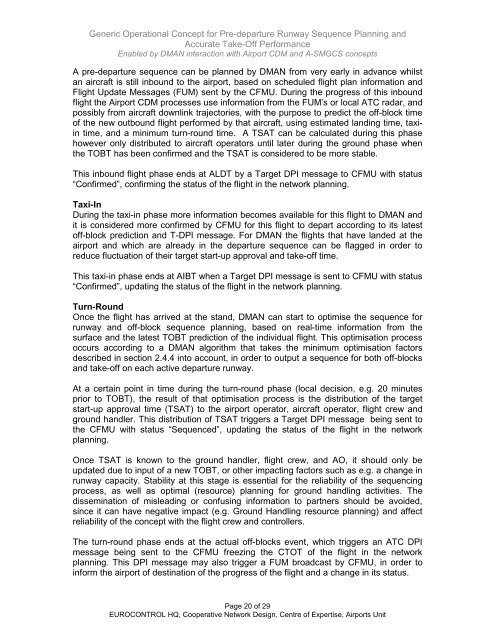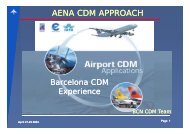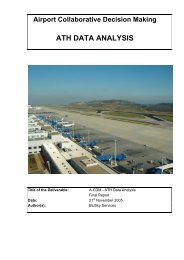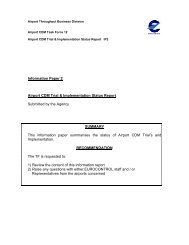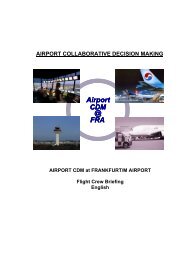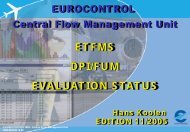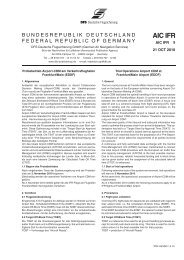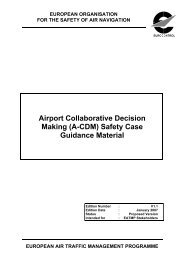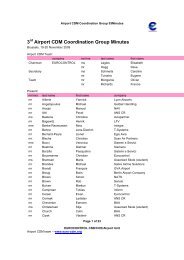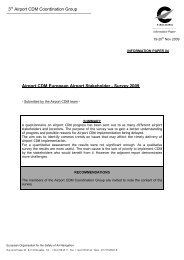Generic Operational Concept for DMAN Interaction v07A - Airport ...
Generic Operational Concept for DMAN Interaction v07A - Airport ...
Generic Operational Concept for DMAN Interaction v07A - Airport ...
Create successful ePaper yourself
Turn your PDF publications into a flip-book with our unique Google optimized e-Paper software.
<strong>Generic</strong> <strong>Operational</strong> <strong>Concept</strong> <strong>for</strong> Pre-departure Runway Sequence Planning and<br />
Accurate Take-Off Per<strong>for</strong>mance<br />
Enabled by <strong>DMAN</strong> interaction with <strong>Airport</strong> CDM and A-SMGCS concepts<br />
A pre-departure sequence can be planned by <strong>DMAN</strong> from very early in advance whilst<br />
an aircraft is still inbound to the airport, based on scheduled flight plan in<strong>for</strong>mation and<br />
Flight Update Messages (FUM) sent by the CFMU. During the progress of this inbound<br />
flight the <strong>Airport</strong> CDM processes use in<strong>for</strong>mation from the FUM’s or local ATC radar, and<br />
possibly from aircraft downlink trajectories, with the purpose to predict the off-block time<br />
of the new outbound flight per<strong>for</strong>med by that aircraft, using estimated landing time, taxiin<br />
time, and a minimum turn-round time. A TSAT can be calculated during this phase<br />
however only distributed to aircraft operators until later during the ground phase when<br />
the TOBT has been confirmed and the TSAT is considered to be more stable.<br />
This inbound flight phase ends at ALDT by a Target DPI message to CFMU with status<br />
“Confirmed”, confirming the status of the flight in the network planning.<br />
Taxi-In<br />
During the taxi-in phase more in<strong>for</strong>mation becomes available <strong>for</strong> this flight to <strong>DMAN</strong> and<br />
it is considered more confirmed by CFMU <strong>for</strong> this flight to depart according to its latest<br />
off-block prediction and T-DPI message. For <strong>DMAN</strong> the flights that have landed at the<br />
airport and which are already in the departure sequence can be flagged in order to<br />
reduce fluctuation of their target start-up approval and take-off time.<br />
This taxi-in phase ends at AIBT when a Target DPI message is sent to CFMU with status<br />
“Confirmed”, updating the status of the flight in the network planning.<br />
Turn-Round<br />
Once the flight has arrived at the stand, <strong>DMAN</strong> can start to optimise the sequence <strong>for</strong><br />
runway and off-block sequence planning, based on real-time in<strong>for</strong>mation from the<br />
surface and the latest TOBT prediction of the individual flight. This optimisation process<br />
occurs according to a <strong>DMAN</strong> algorithm that takes the minimum optimisation factors<br />
described in section 2.4.4 into account, in order to output a sequence <strong>for</strong> both off-blocks<br />
and take-off on each active departure runway.<br />
At a certain point in time during the turn-round phase (local decision, e.g. 20 minutes<br />
prior to TOBT), the result of that optimisation process is the distribution of the target<br />
start-up approval time (TSAT) to the airport operator, aircraft operator, flight crew and<br />
ground handler. This distribution of TSAT triggers a Target DPI message being sent to<br />
the CFMU with status “Sequenced”, updating the status of the flight in the network<br />
planning.<br />
Once TSAT is known to the ground handler, flight crew, and AO, it should only be<br />
updated due to input of a new TOBT, or other impacting factors such as e.g. a change in<br />
runway capacity. Stability at this stage is essential <strong>for</strong> the reliability of the sequencing<br />
process, as well as optimal (resource) planning <strong>for</strong> ground handling activities. The<br />
dissemination of misleading or confusing in<strong>for</strong>mation to partners should be avoided,<br />
since it can have negative impact (e.g. Ground Handling resource planning) and affect<br />
reliability of the concept with the flight crew and controllers.<br />
The turn-round phase ends at the actual off-blocks event, which triggers an ATC DPI<br />
message being sent to the CFMU freezing the CTOT of the flight in the network<br />
planning. This DPI message may also trigger a FUM broadcast by CFMU, in order to<br />
in<strong>for</strong>m the airport of destination of the progress of the flight and a change in its status.<br />
Page 20 of 29<br />
EUROCONTROL HQ, Cooperative Network Design, Centre of Expertise, <strong>Airport</strong>s Unit


